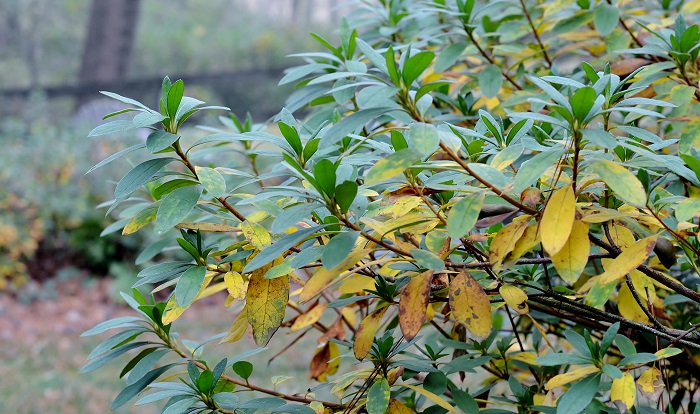Why are my azalea leaves turning yellow?
Well it’s happening again … many of the leaves on my azaleas have turned yellow. So as I did last year, I’m briefly interrupting our holiday-related posts to re-post the answer to a question that I’ve had…and one that several of my clients have asked me recently … Why are my azalea leaves turning yellow?

![]()
It seems that every year around this time a disproportionate number of my azaleas’ leaves have turned yellow…and the bright yellow really stands out because the only other colors going on in my yard are green and brown. So what’s up?
 Since I’m pretty much a self-taught landscape designer (i.e., I don’t have a degree with anything plant in it), I wanted to make sure that I was complete and accurate with my answer…so I reached out to my all-around-plant-guru-friend Holly Brooks from King Landscaping. And here are three potential answers we’d like to suggest…and what you should do about it, if anything.
Since I’m pretty much a self-taught landscape designer (i.e., I don’t have a degree with anything plant in it), I wanted to make sure that I was complete and accurate with my answer…so I reached out to my all-around-plant-guru-friend Holly Brooks from King Landscaping. And here are three potential answers we’d like to suggest…and what you should do about it, if anything.
- There’s nothing to worry about at all, they’re just molting…losing their leaves. Even evergreens lose their leaves…just not all at once like deciduous plants do. Azaleas set their leaf buds in the fall…and the emergence of these buds prompts molting. Having random yellow leaves scattered throughout your azaleas is normal…these leaves are simply molting. There’s nothing you need to do or worry about. Just wait for new growth in the spring.
- There’s nothing to worry about…they may just need to be fertilized – but wait. It may be that your azaleas are just needing a little bit of extra juice…particularly nitrogen. Nitrogen-deficient azaleas seem to shed even more leaves…hence more of them turn yellow. But don’t run out and fertilize them now … wait until the spring. If you fertilize them now it may cause them to start producing new leaves … which you don’t want, because this tender new growth would likely be burned during the winter’s cold weather. Just enjoy your yellowy garden, have patience, and rest in knowing there’s nothing you should do now.
- However, there could be an insect issue. Silvery and yellow mottled or even bleached-looking leaves indicate a potential lace bug infestation … one of the most common pests to azaleas. If you can’t tell whether the leaves are molting or have an insect problem, simply look at the underside of the leaves. If it seems like there’s crusty dirt, you have lace bugs … but it’s not dirt, it’s bug feces…lovely! And if you do, you need to act fast…lace bugs are active breeders so a small problem can quickly become a big problem. So spray them with insecticidal soap … making sure to drench the underside of the leaves.

Fortunately for me … there’s no dirt on the underside of my azaleas’ leaves … so it’s just the normal molting process. I’ll simply wait for their normal burst of flowers and new leaf growth in the spring. Now, I may throw out a bit of nitrogen-rich fertilizer after the last frost of the year just to be on the safe side to hopefully minimize all the yellow next year. We’ll see.
![]() I hope this post has helped any of you who have ever wondered why are my azalea leaves turning yellow.
I hope this post has helped any of you who have ever wondered why are my azalea leaves turning yellow.
Take care all,

Affiliate Disclosure: RYG may earn a small commission from qualifying purchases when links take you to Amazon.com. Learn more…
You may also enjoy these posts from RYG ...
If you're not already subscribed to RYG and want to get periodic updates, links to new posts & other ground redeeming info ... just enter your email address below. Easy as that!

![Natural Play Spaces – Best for Your Kids’ Bodies & Minds [Guest Post by Holly Brooks | King Landscaping]](https://redeemyourground.com/wp-content/uploads/2015/07/Natural-Play-Spaces-RYGblog3-150x150.jpg)




Thank you! Was just wondering about that 🙂
Glad I could be of service Yane!!!! Take care friend, D.
All my azalea bushes on one side have lost their bright green leaves and turned paler … a yellow green. I live in Florida, soil is sandy so I water frequently but did put good soil in the ground when I planted them. One bush of the same lot a distance away has bright dark healthy looking green leaves. Am I over watering? I was told that in my soil it was nearly impossible to do.
They aren’t spotted so I don’t think it’s bugs, I think it’s me…help!
Hey Linda, sorry for my delinquent response…busy time of year for landscaping folks. Hopefully your azaleas have taken a positive turn by now! But if not … here are some of my thoughts. I’m originally from Florida, so I know all about Sandy soil, so I think what you’ve been told is correct … probably not overwatering. I think you’re also right that it doesn’t sound like bugs … you would notice them buzzing around or seen them on the undersides of the leaves if it was. My guess is that those azaleas are just shedding some of their leaves … and the fact that some of your azaleas on one side of your yard are turning yellower may just be a function of their growing conditions (sun exposure, soil quality, etc.). You can’t do much about sun exposure unless you want to transplant them. So you could scratch in some 10-10-10 general fertilizer or a fertilizer that’s specifically made for azaleas/rhododendrons … or add some organic material under them. I hope this helps, please reach out if you have any other questions. Take care, D.
I live in the North East and my Azalea bush seems to have more yellow and brown leaves than I remember from previous years. In the spring I always put my coffee grounds around the bush and this gives them a nice dose of nitrogen to start the season.
Hey Glenda…thanks for chiming in. And great tip on the coffee grounds…thanks for sharing! I actually did a post back in September about the benefits of using coffee grounds in your garden…prompted by Starbucks’ “Grounds for your Garden” program. Here’s the link if you’re interested: https://redeemyourground.com/redeem-grounds-coffee-grounds/.
I use my coffee grounds like I do our bunny’s manure…simply spreadin it around my planting beds as mulch. I know that both are great added to your compost pile as well…and if I composted, I probably would too. However, since both are bioavailable (and the bunny manure doesn’t burn plants like other manures) they are great when simply added directly to your plants…either as mulch on top or amended into the soil.
Thanks again Glenda. Please check back in for other posts…and I’d love for you to add other words of gardening wisdom from your experience.
Take care, D.
Having a problem with 20 year old azaleas dying. Last summer noticed one plant was dying – 1 branch at a time. This year it is only a skeleton. In same natural area, the azalea beside it looks like the same thing may be happening. I have a natural area on each side of drive, with approximately 5 azaleas in each area (with other smaller plants) , and these both have some of the same symptoms starting to appear. Please advise. Have seen no evidence of moles/voles in this area, but found fire ants, very very small, last summer.
Betty…I’m so sorry that I’m late in responding to you. I’ve been down and out with the flu. I have had similar problems with some of my older azaleas. There are a number of reasons why this is happening…drought conditions, fungal diseases, borers, etc. But since you mentioned that they are old, I’m thinking it might be due to fungus. You see…like us, as azaleas age their immune systems can weaken…making them more susceptible to soil borne fungus. Depending on how far gone a plant is, you can try to prune out the dead limbs…in hopes of new growth filling in. That’s what I have done w some of my azaleas, and have gotten a few more seasons out of them. However, with others…as sad at it is…I have just replaced them with younger, healthier plants. I hope this helps…but if you want to read further, here’s a link that might give you more insight: http://forums.gardenweb.com/discussions/1730029/old-azaleas-dying-in-sections. Thanks for reaching out Betty and good luck! – D.
Thank you for the advice and pics which look exactly like my mature azaleas in my winter garden (Australia).
Hey Linda…glad the info we provided helped. And thanks for chiming in and letting me know about your azaleas in your winter garden. We love ours in the Southern states of the US! Take care, D.
Mim ajuda por favor mudei minha azaleia que estava no vaso pequeno e agora só fica amarelo será que vai morrer? Estão saindo poucas flores. As flores estão linda! mais as folhas Amarela mim sina algo caseiro para mim usar por favor. Desde de já obrigado !
Olá Mari, desculpe a demora na resposta. Se suas azaleias parecem saudáveis (por exemplo, com flores bonitas), as folhas amareladas provavelmente são normais – apenas o ciclo típico da vida delas. Me avise como suas plantas estão agora… ou se tiver mais alguma dúvida. Obrigada e se cuide, D.
Thank you for this well-written and informative post. I’m an extension Master Gardener, and I swear a good 60% of the problems I help fix could have been avoided if people had only found solid information from knowledgeable sources, instead of throwing Epsom salts on everything because Pinterest said to XD Commenting mostly to boost this post’s SEO rank, you rock, and more people should see your stuff.
[…] Use appropriate soil amendments to adjust the pH level of the soil and create an acidic environment suitable for azaleas. […]
[…] Just like a toddler with a tummy ache, your azalea’s yellow leaves are its way of telling you something’s wrong. Be it an overzealous watering schedule, nutrient deficiency, poor drainage or pests, we’ve covered all the bases in Why is My Azalea Turning Yellow. […]
Thank you for the helpful advice and photos—they look exactly like my mature azaleas in my winter garden.